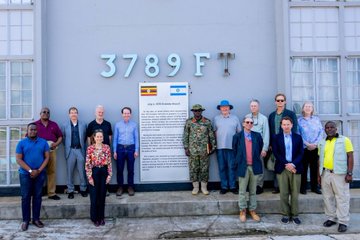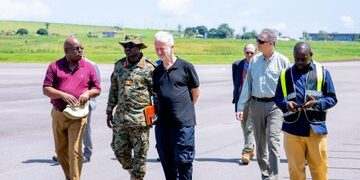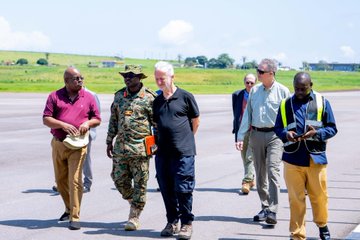Entebbe – On June 7, 2025, a group of foreign tourists from Europe and the United States visited the Old Airport Entebbe, the site of one of the most audacious hostage rescue missions in modern history, known as Operation Thunderbolt.
The daring operation, executed by Israeli commandos on July 4, 1976, successfully freed over 100 hostages and left a lasting mark on global counter-terrorism efforts.
The tourists were accompanied by renowned Ugandan media executive Conrad Nkutu, who provided insights into the historical significance of the site, according to Col Chris Magezi, Acting Director of Defence Public Information.
Background: The Entebbe Hijacking
The events leading to Operation Thunderbolt began on June 27, 1976, when Air France Flight 139, an Airbus A300 carrying 248 passengers and 12 crew members, was hijacked shortly after a stopover in Athens.
The hijackers, comprising two members of the Popular Front for the Liberation of Palestine – External Operations (PFLP-EO) and two German members of the Revolutionary Cells, diverted the flight to Benghazi, Libya, before landing at Entebbe International Airport in Uganda.
There, they were joined by additional militants and received support from Ugandan dictator Idi Amin, who allowed the hijackers to hold the hostages in the old terminal building.
The hijackers demanded the release of 53 Palestinian and pro-Palestinian militants, 40 of whom were imprisoned in Israel, along with a $5 million ransom for the plane. They threatened to kill the hostages if their demands were not met by July 1, 1976.

After releasing non-Israeli and non-Jewish passengers, the hijackers held 106 hostages, primarily Israelis and Jews, in a chilling echo of historical selections that evoked memories of the Holocaust for some.
Operation Thunderbolt: A Daring Rescue
Faced with an escalating crisis, the Israeli government, led by Prime Minister Yitzhak Rabin and Defence Minister Shimon Peres, opted for a military solution. Codenamed Operation Thunderbolt (later renamed Operation Yonatan in memory of its fallen commander), the mission involved 100 elite commandos, primarily from the Sayeret Matkal unit, led by Lt. Col. Yonatan “Yoni” Netanyahu. The operation was a logistical marvel, requiring four C-130 Hercules transport planes to fly over 2,500 miles from Israel to Uganda undetected.
On the night of July 3, 1976, the commandos landed at Entebbe under the cover of darkness. To deceive Ugandan forces, they used a black Mercedes sedan resembling Idi Amin’s vehicle and wore uniforms mimicking those of Ugandan soldiers.
Despite a brief firefight triggered by a suspicious sentry who noticed the Mercedes was not Amin’s white model, the commandos stormed the terminal, neutralised all seven hijackers, and eliminated 45 Ugandan soldiers who resisted. They also destroyed 11 Ugandan Air Force MiG-17 and MiG-21 fighter jets to prevent pursuit.
Within 90 minutes, 102 hostages were rescued and loaded onto the aircraft. Tragically, three hostages were killed during the crossfire, and one, Dora Bloch, who had been taken to a hospital in Kampala before the raid, was later murdered on Amin’s orders.
Yonatan Netanyahu, the operation’s commander, was the sole Israeli fatality, struck by gunfire early in the assault. His death was a profound loss, felt deeply by his brothers, Iddo and Benjamin Netanyahu, the latter of whom would later become Israel’s Prime Minister.
The Legacy of Entebbe
Operation Thunderbolt was a resounding success, celebrated as a tactical masterstroke that restored Israeli morale after the setbacks of the 1973 Yom Kippur War and the 1972 Munich Olympics massacre. The raid demonstrated Israel’s resolve to protect its citizens, no matter the distance, and set a precedent for counter-terrorism operations worldwide.
The United States, inspired by the mission, developed rescue teams modelled on Sayeret Matkal, though their attempt in 1980, Operation Eagle Claw, failed.
The operation also had significant repercussions for Uganda. Idi Amin’s support for the hijackers tarnished his regime’s credibility, and his retaliatory actions, including the murder of Dora Bloch and the killing of approximately 245 Kenyans in Uganda for Kenya’s logistical support to Israel, further isolated him internationally.

Kenya’s role, which included allowing Israeli planes to refuel in Nairobi and providing a staging ground for Mossad intelligence operations, was pivotal but kept secret to avoid backlash from the Organisation of African Unity.
Tourists Revisit History
The visit by foreign tourists to the Old Airport Entebbe highlights the enduring fascination with Operation Thunderbolt. Accompanied by Conrad Nkutu, a prominent figure in Uganda’s media landscape, the group explored the site where the dramatic rescue unfolded.
The old terminal, now a historical landmark, stands as a testament to the bravery of the Israeli commandos and the resilience of the hostages. Nkutu’s presence added a local perspective, connecting the event to Uganda’s complex history under Idi Amin’s regime.
The tourists, hailing from Europe and the United States, were drawn to the site’s significance as a symbol of courage and precision. For many, the visit was an opportunity to reflect on the global impact of the raid, which has been immortalised in films such as Operation Thunderbolt (1977), nominated for an Academy Award, and documentaries like Cohen on the Bridge (2010). The event also resonates in popular culture, with books like 90 Minutes at Entebbe by William Stevenson and Yoni’s Last Battle by Iddo Netanyahu offering detailed accounts of the mission.
A Symbol of Resilience
As the world continues to grapple with terrorism, the Entebbe raid remains a powerful reminder of the lengths nations will go to protect their citizens. The tourists’ visit underscores the site’s place in history, not only as a battlefield but as a symbol of hope and determination.
For Uganda, it serves as a point of reflection on a turbulent era, while for Israel, it is a proud chapter in its military legacy. The Old Airport Entebbe continues to attract visitors eager to understand the intricacies of Operation Thunderbolt, ensuring that the courage of the commandos and the resilience of the hostages are never forgotten.










